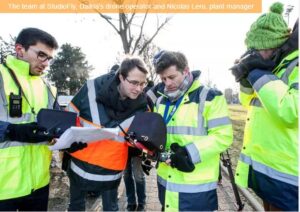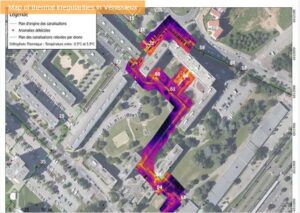Monitoring heating networks to repair deterioration

Heating-network pipes do not last forever! Inspecting their condition helps improve the energy efficiency of installations and, in turn, users’ comfort. In Vénissieux, close to Lyon in France, a drone-mounted thermographic camera is being used for the first time in February 2016 to explore a section of the network.

The solution: more precise pipe inspections
The most common way to inspect hot-water pipes is aerial thermography from helicopters or airplanes, a method that is complicated and costly to implement. Now that miniature cameras and batteries are available, a thermographic camera can be mounted on a drone.
How it works
Thermography is a technique used to capture thermal images of a scene. A camera that can detect infrared (a spectrum of frequencies lower than visible light) records the heat emanating from the subjects filmed. A colour filter is added to facilitate interpretation of the monochromatic images. By filming a network of underground hot-water pipes, we can see leaks caused by cracks or inadequate insulation.

A promising innovation
The initial campaign in Vénissieux – the inspection of a five-kilometre section chosen because recent data were available – demonstrated the increased accuracy of results obtained using drone thermography. The drone is very agile and flies much lower than a helicopter, picking up on irregularities, including some that conventional thermography would not have detected.
The irregularities were caused by seeping wastewater and rainwater that had damaged the insulation in the heating network. The inspection campaign is set to continue and, in time, the entire Vénissieux network will be inspected.
The benefits
Drone thermography is more precise, less expensive and uses less fossil fuel, because the drones are electric.
Environmental benefits:
- Technology that pollutes less than helicopters, makes less noise and is much more precis
- Improved network energy efficiency and a resulting decrease in energy use
Economic benefits:
- Drone inspections campaigns are appreciably less expensive than when using a helicopter
- Improved network maintenance generates savings on energy bills
“The experiment was a success. The drone provides high-quality images at a much lower cost than aerial thermography by plane or helicopter. We have gathered relevant data that we are going to model using our eCare system.”
Nicolas Le Ru
Network Expertise Centre Manager at Dalkia Centre-Est
Source: Dalkia